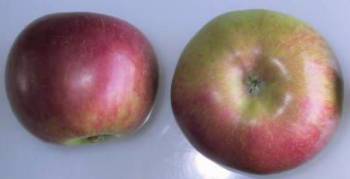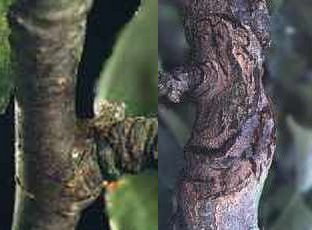HISTORY OF IDARED
The parents are Jonathan and Wagener, first raised in Idaho, USA. It was first released to the public in 1942 after a ten year breeding program.
APPEARANCE, TASTE AND CHARACTERISTICS OF IDARED
Let’s use a comparison to sum up the taste and texture of this variety. If Laxton’s Superb were to be placed in the ice cream category, it would be a full flavoured, sumptuous, chocolate ice cream. Idared on the other hand might be classified as a delicate, lightly flavoured lemon sorbet. No great taste but refreshing and very pleasant. Try eating this variety slightly chilled for the best, refreshing effect.
Idared is a good looking apple with a flattened spherical shape. The background green colour is strongly streaked red on the sun-facing side especially if the apples are left on the tree a long time. The skin is tougher than most and for kids, peeling the apples may well be needed.

Idared Apples
As well as storing well for five months or so, the ripe apples stay on the tree for several weeks. The flesh of the apples are white and normally crisp and juicy with a sweet, if rather bland taste.
BUYING AN IDARED APPLE TREE
Even though Idared has some very useful and appealing characteristics is is slowly but surely becoming less popular in the UK. It is rarely found for sale at garden centres nowadays and few of the discounters sell it. It is however available from several online fruit tree specialists.
It is clear that the prices of quality trees varies enormously depending on your chosen supplier. For example Keepers Nursery look good at first glance. However an advertised price of only £16.50 turns into an exceptionally high £31.00 when you add in their £14.50 delivery charge!
VAT, delivery charges and other incidentals all need to be taken into account! We would also advise that buying a bare-rooted Idared is roughly £10 cheaper than the equivalent potted tree. There is no difference in quality so always try to buy the bare-rooted tree.
Our recommendation for rootstock would be to buy it on either M26 or MM106 for the average sized garden.
PESTS AND DISEASES OF IDARED
Idared has an average to good overall disease resistance. Opinions vary as to how it it is affected by the various diseases and infections which commonly affect apple trees but the consensus is that canker affects it more than the average.
Even if you grow this variety of apple tree in a relatively dry part of the UK, canker will always be a risk. It damages the bark of the tree and the only solution is to cut it out as soon as as you notice it. Early action reduces the risk of further infections. See the picture below:

Canker damage to a fruit tree
For more information about identifying, treating and avoiding canker see our dedicated page for this disease here.
For a full description of common apple pests and diseases click here.
HOW TO PRUNE YOUR IDARED APPLE TREE
This variety is about average as far as tree vigour is concerned so you should have no particular problems pruning it if you follow our step by step guide here.
Idared is a spur bearer which means that the vast majority of fruit buds are formed on short stems along the branches and stems but not normally at the end of branch / stem. This is the normal behaviour for most apple trees. Check out our section on pruning spur bearing apple trees for more detailed information.
ALTERNATIVES TO IDARED
This is one of the more difficult varieties to find alternatives for. Idared can be used as an eater and a cooker and it can be stored for longer than almost any other apple. This sets it aside from most other apple varieties,
A few varieties which fit the replacement criteria to some degree are:
- RED FALSTAFF – a widely available sport of Falstaff. Taste is nearly as good and pest / disease resistance is better. A good looking apple with a red skin
- FIESTA – taste is excellent, the apples are very appealing and pest / disease resistance exceeds that of an Idared.
- LAXTON’S SUPERB – one of the top three best tasting apples of all time in our view. Similar sweetness to Idared but much more apple flavour. This variety has no drawbacks, a great tasting apple with superb looks and good pest and disease resistance.
SUMMARY CHARACTERISTICS OF IDARED
USE: Eating and cooking
SKIN COLOUR / TEXTURE: Green background highly coloured red especially on
the sun side
FLESH COLOUR: White
TASTE AND TEXTURE: Juicy, crisp, sweet but slightly bland taste.
FRUIT SIZE: Average
STORING QUALITIES: Five months plus months
PRODUCES FRUIT: Mid to late October (see here for more details)
SUITABILITY FOR CORDON / ESPALIER GROWTH: Yes
TREE SIZE: Average size depending on rootstock and conditions
REGULARITY OF CROPPING: Regular
POLLINATION: Group 2, self sterile. Needs a matching pollination partner to produce fruit.
AWARDS: RHS AGM 1993
SPECIAL FEATURES: Good for eating and cooking, excellent storage capabilities.
WHEN TO HARVEST IDARED APPLES
The average flowering time (optimum time for pollination) and date when fruits are ripe in the UK for the Idared variety are set out below. If you have set your home town we can give you a more accurate estimate, if you have not set your home town (do it now by clicking here) the dates below will be the average for the UK.
Your town has not been set, the average main flowering time for Idared
in the UK is the last week of April to the first week of May. Fruit will be ready for harvesting in the third week of October.
Click here if you want to set the dates to your home town.
Flowering and fruit picking dates vary according to the weather in any particular growing season so the above dates may well change slightly from one year to the next. The flowering date above is when the apple tree produces the maximum number of blossoms, it will also produce blossom, although less, a week or two either side of the date given.
IDARED POLLINATION
Idared is self-sterile and needs a pollination partner to produce fruit. It is in pollination group 2. We list below varieties which are suitable pollination partners.
- Alkmene – pollination group 2, self-sterile, eater
- Allington Pippin – pollination group 3, partially self-fertile, cooker and eater
- Arthur Turner – pollination group 3, self-sterile, cooker
- Beauty of Bath – pollination group 2, self-sterile, eater
- Bountiful – pollination group 3, self-sterile, cooker
- Charles Ross – pollination group 3, partially self-fertile, cooker and eater
- Court of Wick – pollination group 3, self-sterile, eater and cooker
- Cox’s Orange Pippin – pollination group 3, partially self-fertile (see here), eater and cooker
- Devonshire Quarrenden – pollination group 2, partially self-fertile, cooker
- Discovery – pollination group 3, self-sterile, eating and cider
- Egremont Russet – pollination group 2, partially self-fertile, eater and cooker
- Granny Smith – pollination group 3, self fertile, eater and cooker
- Greensleeves – pollination group 2, self-fertile, eater, cooker, juice
- Grenadier – pollination group 3, partially self-fertile, cooker
- Howgate Wonder – pollination group 3, partially self-fertile, cooker and eater
- James Grieve – pollination group 3, partially self-fertile, cooker and eater
- Katy – pollination group 3, self-sterile, eater
- Kidds Orange Red – pollination group 3, self-sterile, eater
- Laxtons Fortune – pollination group 3, partially self-fertile, eater
- Lord Lambourne – pollination group 2, self-fertile, eater and cooker
- Peasgoods Nonsuch – pollination group 3, partially self-fertile, cooker
- Red Falstaff – pollination group 3, self-fertile, eater
- Red Windsor – pollination group 2, self-fertile, eater
- Reverend W Wilks – pollination group 2, self-fertile, cooker
- Rubinette – pollination group 3, self-sterile, eater
- Scrumptious – pollination group 3, self-fertile, eater
- Sops in Wine – pollination group 3, self-sterile, juicer
- Spartan – pollination group 3, self-fertile, eater
- Sunset – pollination group 3, self-fertile, eater and cooker
- Worcester Pearmain – pollination group 3, partially self-fertile, eater
The full list of apple tree varieties which we have reviewed is listed below. Select any one of them and then click the “More Information” button to be taken to the in depth review:
Rootstocks and Size
Guide to Planting
Care Plan
Pruning Apple Trees
Harvest and Storage
Pests and Disease
Pollination Groups
IDARED APPLE TREE
Idared is an apple tree variety with a limited but very useful purpose in life. Its first attribute is that it stores extremely well for up to six months in the fridge. For the first three months the taste matures and improves. The crisp texture remains largely unaffected by storage.
Its second main virtue is that, as well as being a good eating apple, it is also an excellent cooker which retains it shape. Whilst we wouldn’t recommend it as your first apple tree to buy, its qualities may suit many as a second tree.